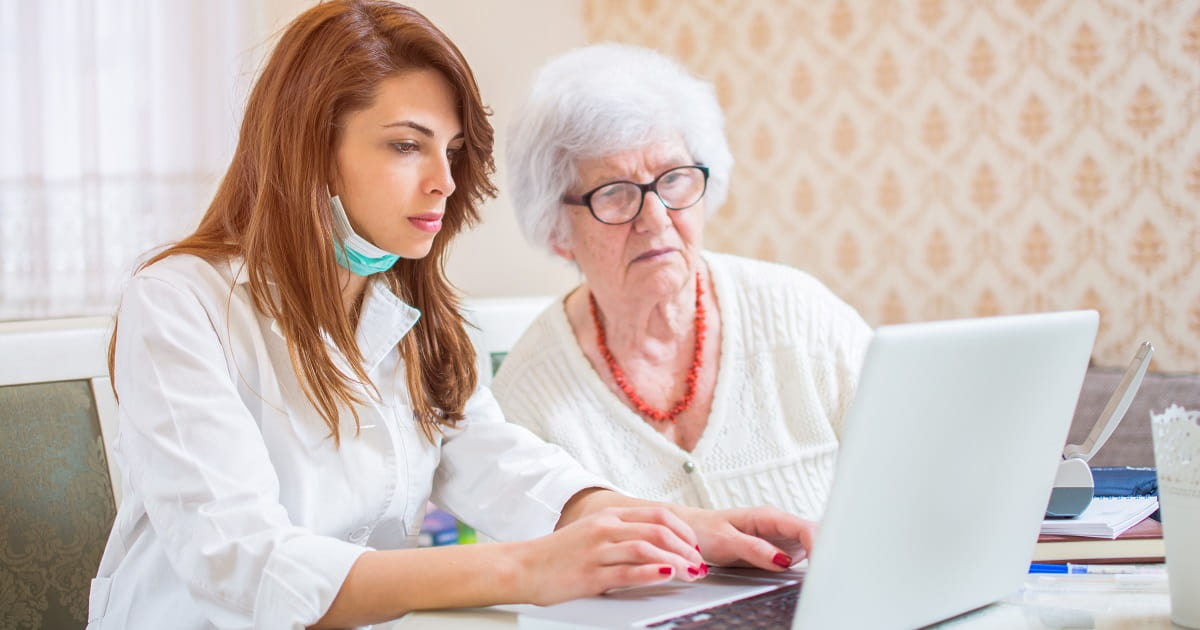
Health Technology, Digital Healthcare
Article | September 7, 2023
Health technologies range from devices, systems, and procedures to vaccines and medications that help deliver high-quality care, reduce costs for hospitals and patients, and streamline operations. It can be any software or IT tool that improves administrative productivity, eases workflow, and enhances the quality of life.
New technology in healthcare includes supportive, educational, information, organizational, rehabilitative, therapeutic, preventive, and diagnostic solutions that improve patient access and healthcare provider capabilities. Virtual concierge, artificial intelligence, voice search, and virtual and augmented reality are promising emerging technologies for 2021.
Read More

Healthtech Security
Article | November 29, 2023
As consumers, we crave convenience and simplicity, and across an array of industries, technology has made it increasingly easy to search for and purchase products and services. From getting a pizza delivered to buying a car online, the process often involves entering a few pieces of information, hitting send, and waiting for a confirmation email.
A Changing Landscape
Unsurprisingly, people want this same level of convenience and simplicitywhen they're seeking care. This change in consumer demand for convenience is further compounded by fundamental shifts in the healthcare ecosystem. Among these shifts are cost-sharing models that have increased patient out-of-pocket expenses, healthcare systems that are increasingly shifting toward delivering value-based care, and innovations in digital health solutions.
While patients want to play an active role in managing their well-being, that is often easier said than done in a system that uses a combination of manual processes and non-integrated point solutions to try and meet consumer demand. Disparate and burdensome methods of managing patient engagement often lead to inefficiencies within provider organizations, resulting in missed appointments, increased registration and eligibility-based denials, incomplete payments, higher collections and write-offs, and low patient satisfaction.
Consumer Dissatisfaction
Healthcare consumers today feel like they're fighting an uphill battle. According to Change Healthcare's 2020 Harris Poll Consumer Experience Index, 67% of respondents agreed that it “feels like every step of the healthcare process is a chore.” A similar percentage, 62%, agreed that “the healthcare system feels like it is set up to be confusing.”
Furthermore, if consumers don’t receive the level of convenience and digitization they want from their current provider, they’re more than willing to seek it out elsewhere. In a recent Black Book survey, 80% of respondents indicated they would be willing to change providers for more convenience even if they were receiving good care from their current provider. An even higher percentage of patients,90%, do not think they have to continue seeing a provider if that provider does not “deliver an overall satisfactory digital experience.”
A Patient-Centric Approach
Improving the patient experiencestarts with humanizing revenue cycle management(RCM) —the administrative process that takes the patient from registration and appointment scheduling to the final payment of a balance. Simply making administrative touchpoints self-service and easy to understand throughout the patient’s financial journey can help humanize revenue cycle management for providers.
How is that possible? By thinking about the patients’ side of the administrative process and leveraging innovative technologies like artificial intelligence, robotic process automation (RPA), natural language processing (NLP), and machine learning. The more that providers’ staffs are able to automate repetitive tasks, the more time they're able to spend helping provide a seamless patient engagement journey that is focused on a patient’s specific needs. In other words, reducing human intervention throughout our technologies allows providers to infuse more human interaction with each patient as they navigate their healthcare journey.
According to Change Healthcare’s 2020 Harris Poll Consumer Experience Index, what patients really want is a retail-like shopping experience with modern, streamlined communication, as thevast majority (81%) agreed that “shopping for healthcare should be as easy as shopping for other common services” via a streamlined access point online. A clear majority (71%) also said they want their health insurance and healthcare providers (68%) to communicate with them using more-modern platforms.
Simplified Scheduling and Payment
The entire clinical-care journey is focused on the specific needs of the patient rather than the provider, so why shouldn’t the patient’s financial journey be handled the exact same way? From a patient-satisfaction perspective, patients are not separating their clinical journey from their financial journey, so providers should start viewing it the same way.
It should be easy to schedule an appointment and modify that appointment if needed. Patients should have to (securely) provide their personal and insurance information only once (digitally and in advance), then be squared away when they show up for their appointment with their provider. In addition, because of COVID-19 and the heightened awareness surrounding personal interaction, it’s important to provide patients with no-contact check-in and waiting room options.
By humanizing RCM, providers can achieve a cohesive end-to-end journey that allows patients to quickly and easily get the care they need complete with clear communication, price transparency , and a provider who truly takes the time to understand their unique situations. By putting the patient back at the center of their care journey, providers can improve care outcomes while also driving maximized business outcomes for their organizations.
Read More

Health Technology, Digital Healthcare
Article | July 14, 2023
Virtual reality (VR), the new technological advancement, is set to transform practices in the healthcare industry. According to Statista, it is estimated that, by 2022, the second largest market share of VR will be from the healthcare industry. Virtual reality in healthcare operates in various divisions to offer a greater quality of patient care and performance of medical professionals. For the health and healthcare industry, from the clinical process to the user, VR has a multitude of applications such as tutoring future doctors, generating new life-saving routines, etc.
Virtual reality in healthcare can confront the challenges in the industry, including efficiently handling huge healthcare databases, training and development of medical professionals, patient engagement, disease awareness, medical marketing, patient treatment, etc. Virtual reality in the healthcare market, according to a report from Reports and Data, is expected to reach USD 8.03 billion by 2027 from USD 2.06 billion in 2019.
This article discusses how virtual reality in healthcare is going to transform the industry by applying it in various divisions such as medical training, patient treatment, patient engagement, disease awareness, and medical marketing.
Virtual Reality in Healthcare Training
VR in healthcare can transport you to areas, inside of the human body, that otherwise would be impossible to access and view. Medical students currently use cadavers to learn, but cadavers do not react the same way live patients do. Also, cadavers are very difficult to get hold of. When VR is used in healthcare training, students can view even minute detail of all parts of the body. This view is possible in stunning 360° CGI reconstruction and creates training scenarios, which would replicate real surgical procedures.
Virtual Reality in healthcare can be used to deliver high-quality surgical training. Using virtual reality, 4K 360° video of real-life surgery is filmed from multiple angles. Then it is combined with CGI models of the anatomy, which is being operated. This advanced use of virtual reality in healthcare provides medical students with an interactive and immersive training experience.
Treatment
Patient Education
The ability of virtual reality in healthcare to see inside of the human body is useful for both doctors and patients. With the help of VR, doctors can take patients through their surgical plan. This is made possible by a virtual view of the anatomy and pathology of patients through a patient-specific 360° VR reconstruction. The result of this is an enhanced understanding of the treatment for patients and higher patient satisfaction.
Robotic Surgery
Robotic surgery is a recent innovation. A robotic device, such as a robotic arm, is used in a robotic surgery while being controlled by a human surgeon. This utilization of virtual reality in healthcare makes sure of fewer or no risk of complications in surgeries. This also makes the surgeon finish the surgery procedure faster with greater accuracy. The robotic devices are accurate with reduced blood loss, smaller incisions, and faster recovery.
Mental Health and Psychological Therapy
The unique ability of virtual reality technology to take you anywhere virtually can be utilized to create a powerful virtual reality simulation in healthcare of various scenarios in which psychological issues occur. This eliminates the necessity of a therapist accompanying patients to various scenarios such as a tall building or a crowded shopping center to provide proper counseling. These scenarios can be easily created with virtual reality technology in healthcare. Virtual reality in healthcare market has also been used to help autistic children in the classroom, curb memory loss, and gather data for dementia research.
Pain Management and Physical Therapy
Apart from psychological issues, the healing capabilities of VR are also used in pain management and physical treatment. According to a study by the UW Harborview Burn Centre and the University of Washington Seattle, a full VR immersion acted as a distraction for patients, who were undergoing physical therapy after a skin graft. This distraction subsequently reduced their feeling of pain.
Virtual reality in healthcare is also found to be effective in reducing recovery time in physical therapy. Patients performing their daily exercises in a virtual environment, find the task to be more fun than usual. It also keeps the patients focused and helps them keep their spirits up and recover sooner.
Patient Engagement
With the help of virtual reality in healthcare, patients can experience a virtual tour of the inside of their bodies before surgeries. This is a 360-degree, three-dimensional (3D) tour. This enables patients to know their body, anatomy, and pathology, before the surgical procedures. Virtual Reality Medical Visualization platform is developed for the tour.
These advancements with virtual reality in healthcare engage patients thoroughly, which reduces tension and lead to a speedy recovery.
Medical Marketing
The most popular and initial application of Virtual reality was marketing. Still, it continues to be one of the most effective and powerful marketing tools. The ability to use VR to project the future of healthcare is the most powerful tactic in healthcare marketing. With Virtual reality in healthcare, one of the most powerful tactics that you can have to market in the industry is to show people what changes they can expect when they start or stop exercising, lose or gain weight, the progress they make through cancer treatments, etc.
As the possibilities of virtual reality in healthcare are endless, healthcare professionals and providers can attract more patients, doctors with high caliber, and nursing staff to your facilities. When those are in short supply, virtual reality in healthcare can be used as an excellent healthcare marketing tool to ensure expected results.
Disease Awareness
AbbVie, a pharmaceutical research & development company, created an experience to educate medical professionals and raise awareness among them regarding the daily struggle Parkinson’s disease patients undergo. The experience was demonstrated at a pharmaceutical industry trade show. People put on a headset and experienced how Parkinson’s sufferers navigate a virtual supermarket, meeting with difficult moments when they come in contact with other people.
Such experiences with virtual reality in healthcare help raise awareness for various diseases among professionals and patients. Virtual reality presentations can be conducted to raise awareness of certain diseases.
The Future of Virtual Reality in Healthcare
A lot of applications of virtual reality in healthcare are in their nascent stage. In the coming years, virtual reality will be used more in healthcare, which will improve the effectiveness and accuracy of present procedures. It will also enhance the various human capabilities, for both patients and medical professionals. Virtual reality in healthcare has huge potential, but only limited by the ingenuity and creativity of people who create and apply the technology. VR will surely transform medical training, physical and psychological therapies, rehabilitation, mental health treatments, and patient engagement, among others.
Virtual reality in healthcare holds the power to transform the way doctors are trained and treatment is provided to patients. According to reports from various market research companies, especially research done by Grand View Research, predict that, by 2025, virtual reality in the healthcare market will grow to a whopping US$5.1 billion. The major driving forces behind this growth are Rapid technological advancements in the healthcare industry and driving demand for rehabilitation and simulation training.
Frequently asked questions
How is virtual reality used in healthcare?
In healthcare, virtual reality is used in treatment, training, and to raise awareness among medical professionals and patients regarding various diseases. Patients and doctors are made to view the inside of the human body using virtual reality.
Where is virtual reality used in healthcare?
Virtual reality is used in various sectors of healthcare to deliver high quality patient care. Treatment with the assistance of virtual reality also increases the efficiency of medical professionals. Virtual treating is applied in all aspects of medical treatment.
What are the benefits of virtual reality?
Virtual reality in healthcare saves both, the time and money of healthcare providers. It also makes the work of medical professionals more convenient. It eliminates unnecessary travel for treatments by making appropriate decisions.
How virtual reality is changing healthcare?
Virtual reality is changing the healthcare by providing different advanced ways of treatments, especially for physical and psychological therapy, surgeries, pain management, and stress management and by assisting the rehabilitation process effectively.
Read More

Future of Healthcare
Article | December 8, 2020
Let’s face it. It’s been one tough year with too many of us sitting idle and indulging in calorie-laden foods for way too long as the coronavirus pandemic continues to sweep the globe. For all too many, sheltering in place has prompted unwelcome weight gain—a troublesome truth as we head into the holiday season where gluttony oft reigns supreme.
That said, many individuals did have foresight and motivation back in March and the months that followed, wisely leveraging that extreme downtime to “diet for dollars” with HealthyWage—a pioneer of money-driven weight loss contests and challenges for individuals, teams and business groups. In fact, those who started a 6-month HealthyWager challenge during the pandemic (late March through May) broke company records, spurring a dramatic increase in pound shedding success rates—and in-kind cash payouts—against the norm. So motivated became America to drop, or avoid, the so-called ‘quarantine 15’ and score some cold hard cash in the process, HealthyWage reports that this past May it logged a substantial year-over-year increase in challenge participants at large. This is not surprising given Google search trends indicates the portion of people searching for weight loss hit a 5-year high in May of 2020—a level even exceeding the quintessential New Year’s diet resolution season.
Beyond the fact that people who started weight loss wagers during the pandemic achieved much greater success as compared to participant results the prior year, and earning hundreds and even thousands of dollars for their efforts, it is women and individuals under 30 years of age primarily accounting for the sustained increases. For example, among the litany of pandemic era success stories, Lisa S. won over $1,900 for losing 50 pounds in 6 months while Hayden T. won over $1,200 for losing over 62 pounds in 6 months—both during the COVID-19 pandemic.
As the coronavirus rages on well into the fourth quarter, we collectively find ourselves again having to shelter-in-place. Those trying to reconcile how they will survive this next round of being home bound, and the holiday season at large, with mitigated waistline and budgetary wreckage—and who are even planning their New Year resolution approach just beyond—would be wise to consider the gamified dieting approach. “Loss Aversion is a powerful dynamic and the reality of having ‘skin in the game’ can propel the results of a gamified weight loss initiative,” notes HealthyWage co-founder David Roddenberry.
The efficacy of diet gamification is well-proven. For one, according to study findings published by JAMA Internal Medicine, behavioral economics-based gamification led to “significantly” increased physical activity among overweight and obese Americans. In this particular study, pairing a step tracking device with social incentives led to sustained, long-term behavior change—prompting participants to take more steps then with a step tracking device, alone. While the report explains that “gamification interventions significantly increased physical activity during the 24-week intervention,” with competition being the “most effective.”
That’s something HealthyWage has seen play out since launching its weight-loss gamification platform in 2009. HealthyWage is, in fact, founded on earlier substantive research and "double-incentivization" methodology that proves competition and rewards—especially the cash variety—can as much as triple the effectiveness of weight loss programs.
“A key element for the success of a gamification program is giving participants something to lose if they fail to meet their goal—whether tangible or intangible,” notes Roddenberry. “In this particular study, it was just points at stake but even this effected behavior change. There are actually throngs of studies demonstrated that the threat of losing something of value is much more effective than the opportunity to win something of equal value. That’s precisely why we advocate that program participants ‘pay to play’ and make an investment out of their own pocket in order to win rewards—in our case large cash prizes—for losing weight and getting more active in the program.”
A few other notable HealthyWager success stories (both female and male) are case-in-point. These include Jean N. who lost 71 lbs. and won $3,357.99 for her efforts, and Jeremy M. who also lost 71 lbs. and won $1,886.32 for his own slimdown success. From its website, HealthyWage.com shares yet more inspirational success stories of both women and men who gained financially for their pound-shedding achievements using the company’s unique gamification approach. This includes Kristin W. who lost a staggering 114 pounds and won $4,000 for her efforts, Anastasia W. who lost 41 pounds and won a whopping $10,000 in kind, and Blake S. who lost an impressive 151 pounds and won $4,670 for his own slimdown success. Figures that are tasty, indeed.
These and other such HealthyWage payouts are proof positive. For their weight-loss achievements that collectively exceeds an astounding 1,050,000 pounds for this year, alone—269 of which losing in excess of 100 pounds (and nearly 7.5 million pounds lost since the company’s launch), HealthyWage has reportedly paid more than xx30,000 dieters over $13 million cash in 2020, specifically, and over $55 million cash since its inception in 2009.
HealthyWage programs apply these principles:
HealthyWager Challenge: participants commit to a weight loss goal and an upfront financial payment and get their money back plus a financial return if they accomplish their weight loss goal. The average participant loses 40.7 pounds and gets paid $1,245.
HealthyWage Step Challenge: participants commit money and agree to increase their steps by 25% over 60-days. If they achieve their goal they get their money back plus the money from those who don't hit their goal.
Upholding the new findings while also further validating HealthyWage’s well-honed approach, an additional study published in the journal Social Science and Medicine continue to prove that money is an effective motivator to “increase both the magnitude and duration of weight loss.” The same hold true in business for staff wellness initiatives. Results from one study published in the Annals of Internal Medicine indicated that “Loss Incentive’ Motivates Employees to Take More Steps ,” finding that financial incentives framed as a loss were most effective for achieving physical activity goals.
As a prolific corporate and group wellness purveyor, since 2009 HealthyWage has worked with an array of hi-caliber participants on workplace and staff wellness initiatives, including Halliburton, ConocoPhillips and more than 25% of the largest school districts in the country. HealthyWage has, in fact, formally created competitive, money-motivated programs for more than 1000 Fortune 500 and other public and private companies, hospitals, health systems, insurers, school systems, municipal governments and other organizations throughout the U.S., and their program has been more informally run at more than 7,000 companies and organizations seeking to bolster staff health and well-being, and boost bottom lines in kind.
“Throngs of studies reiterate the importance of the 'stick' in the design of a wellness incentive program, whether for individuals at home or for employee groups,” Roddenberry says. “Many studies have demonstrated that the threat of losing something of value is much more effective than the opportunity to win something of equal value. That’s precisely why we advocate that program participants ‘pay to play’ and make an investment out of their own pocket in order to win rewards—in our case large cash prizes—for losing weight and getting more active in the program.”
Studies do consistently show that monetary incentives serve to enhance the effectiveness of, and duly complement, weight-loss programs of any and all sorts, especially when paid out quickly like HealthyWage’s various programs. For its part, HealthyWage reports that the average participant more than doubles their investment if they are successful at achieving their goal. The financial upside potential is impressive.
So, if this is the season when you would like to not only resolve to lose those extra lbs. but also actually achieve that worthy goal, consider a cash-fueled approach. It just might give you that extra dose of motivation that’ll truly help you stay the course, shed weight and make some extra money in the process. There’s no better time than right now to bank on yourself.
Read More